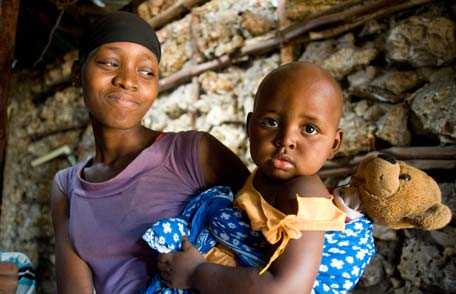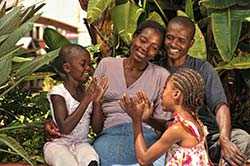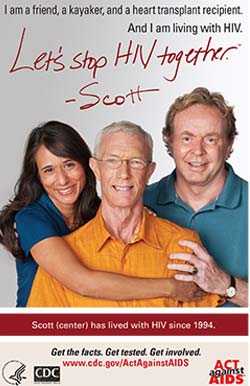World AIDS Day 2016
 Leadership. Commitment. Impact.
Leadership. Commitment. Impact.
December 1 is World AIDS Day, a day to acknowledge our progress in HIV prevention and treatment around the world and renew our commitment to a future free of HIV. This year’s theme, Leadership. Commitment. Impact., calls leaders to strengthen their commitment to using evidence-based HIV interventions, prevention tools, and testing efforts to help us stop HIV.
Our Global Response
Globally, an estimated 36.7 million persons are living with HIV/AIDS. Each year, more than 1 million people die from AIDS-related causes and 2.1 million people become newly infected by HIV. Two-thirds of new HIV infections worldwide occur in sub-Saharan Africa. As a key implementing agency of the U.S. President’s Emergency Plan for AIDS Relief (PEPFAR) , CDC works side by side with Ministries of Health, community groups, and other partners in more than 50 countries to combat HIV, and ultimately, bring an end to the epidemic worldwide.

CDC is working with partners in the US and around the world to achieve a future free of HIV.
CDC brings the power of scientific expertise and on-the-ground experience to deliver sustainable prevention, treatment, and care to millions of people in countries most affected by HIV and tuberculosis (TB).
Specifically, CDC’s Division of Global HIV & TB (DGHT) is working with country partners to:
- Scale up the use of antiretroviral treatment among people living with HIV.
- Strengthen local governments’ ability to provide effective, sustainable HIV services.
- Deliver the most effective prevention tools to those at high risk for HIV infection.
- Use data to reach high-risk groups, inform public health policies and strategies, and measure our impact.
Countries are working to achieve the UNAIDS ’90-90-90′ targets, which call for 90 percent of people living with HIV to know their status, 90 percent of those diagnosed to start and stay on antiretroviral therapy (ART), and 90 percent of those on ART to have a suppressed viral load to protect their own health and prevent transmission of HIV. Global efforts have resulted in 18.2 million people receiving ART for HIV infection as of June 2016, compared to 7.5 million at the end of 2010. In conjunction with World AIDS Day, CDC is releasing two studies in its Morbidity and Mortality Weekly Report (MMWR) that provide important insights to help guide the global response to HIV – particularly in high burden areas. One study assesses the past and current state of early infant diagnosis in some of the world’s most affected countries. The second study (coming December 2) speaks to global efforts around viral load testing.
CDC’s innovative programs are helping countries collect and use more detailed data to target HIV prevention and treatment services to where they are needed most. In 2015, as part of PEPFAR, CDC was responsible for supporting:
- Lifesaving ART for 5.8 million men, women and children.
- Voluntary medical male circumcision procedures for more than 1.3 million men to prevent HIV.
- HIV testing and counseling for nearly 40 million people.
- ART for more than 424,000 HIV-positive women to help reduce the risk of mother-to-child HIV transmission.
- More than 400,000 HIV-positive persons who were screened in care for TB .
Efforts to strengthen health systems, including sustainable human resources for health (e.g., health care workers) and accurate, reliable laboratory networks such as the Labs for Life partnership.
The United States has made an unwavering commitment to support partner governments and other stakeholders to turn the tide on HIV and achieve the 90-90-90 global targets aimed at ending HIV worldwide.
To learn more about global HIV efforts, visit DGHT’s World AIDS Day landing page.

The Let’s Stop HIV Together campaign fights stigma and raises awareness about HIV.
Our Domestic Response
In 2015, 39,513 people were diagnosed with HIV infection in the United States. More than 1.2 million people are living with HIV, and about 1 in 8 don’t know it.
But we have seen encouraging trends in some populations. The number of new HIV diagnoses fell 19% from 2005 to 2014, with large declines among heterosexuals and persons who inject drugs (PWID). Gay and bisexual men continue to be the most affected population, accounting for two-thirds of new diagnoses.
Though HIV diagnoses have fallen among PWID, that progress could be threatened by the prescription opioid and heroin epidemics. If PWID share syringes, they are at high risk for getting HIV. According to CDC’s latest Vital Signs, only a quarter of PWID (in 22 US cities) got all their syringes in the past year from sterile sources like syringe services programs (SSPs) or pharmacies. SSPs can help prevent HIV infections among PWID by providing better access to sterile syringes, help quitting drugs, and other services.
CDC will continue to work with our partners to focus prevention efforts in the United States on the populations most at risk. CDC’s prevention activities include:
- Providing funding and technical assistance to health departments and community-based organizations.
- Conducting HIV surveillance and prevention research.
- Developing guidelines for HIV treatment, prevention, surveillance, and laboratory procedures .
- Evaluating prevention programs .
- Providing training and capacity building assistance in HIV prevention interventions and strategies .
- Focusing attention on HIV in the United States through Act Against AIDS communications campaigns, including
Together we have made great progress in preventing and treating HIV, but there is still much to do. On World AIDS Day, CDC joins partners in the United States and around the world to take action to achieve a future free of HIV.
- Page last reviewed: November 29, 2016
- Page last updated: November 29, 2016
- Content source:
- National Center for HIV/AIDS, Viral Hepatitis, STD, and TB Prevention
- Page maintained by: Office of the Associate Director for Communication, Digital Media Branch, Division of Public Affairs




 ShareCompartir
ShareCompartir